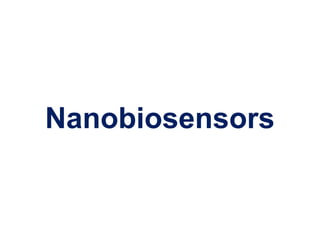
Biosensors general ppt
- 2. Outline • Biosensor Background – What is a Biosensor? – Components of a Biosensor – Principles of Detection • Biosensors on the Nanoscale – Current Research – Potential Applications • Conclusion
- 3. What is a Biosensor? “Biosensor” once refered to any device which responds to chemical species in biological samples or using biological components. www.wvminesafety.org http://www.gentronix.co.uk/images/newscientist.jpg
- 4. Current Definition for Biosensors: A sensor that integrates a biological element with a physiochemical transducer to produce an electronic signal proportional to a single analyte which is then conveyed to a detector. www.imec.be/ovinter/static_research/BioHome.shtml
- 5. Components of a Biosensor http://www.dddmag.com/images/0409/HTS1_lrg.jpg Detector
- 6. 1ST Component: Biological Element Microorganism Tissue Cell Organelle Nucleic Acid Enzyme Enzyme Component Receptor Antibody The component used to bind the target molecule. http://www.chemistry.wustl.edu/~edudev/LabTutorials/HIV/DrugStrategies.html Must be highly specific, stable under storage conditions, and immobilized.
- 7. 2ND Component: Physiochemical Transducer Acts as an interface, measuring the physical change that occurs with the reaction at the bioreceptor then transforming that energy into measurable electrical output.
- 8. 3RD Component: Detector Signals from the transducer are passed to a microprocessor where they are amplified and analyzed. The data is then converted to concentration units and transferred to a display or/and data storage device. www.modernmike.com
- 9. Principles of Detection measures change in mass measures change in electric distribution measures change in light intensity measures change in heat
- 10. Principles of Detection Piezo-Electric Biosensors The change in frequency is proportional to the mass of absorbed material. Some piezo-electric devices utilize crystals, such as quartz, which vibrate under the influence of an electric field. The frequency of this oscillation depends on their thickness and cut. electronics.howstuffworks.com Others use gold to detect the specific angle at which electron waves (surface plasmons) are emitted when the substance is exposed to laser light.
- 11. Principles of Detection Electrochemical Biosensors •Amperometric for applied current: Movement of e- in redox reactions detected when a potential is applied between two electrodes. •Potentiometric for voltage: Change in distribution of charge is detected using ion-selective electrodes, such as pH-meters. •Conductimetric for impedance http://www.lsbu.ac.uk/biology/enztech/index.html
- 12. Principles of Detection Optical Biosensors •Colorimetric for color: Measure change in light adsorption as reactants are converted to products. •Photometric for light intensity: Photon output for a luminescent or fluorescent process can be detected with photomultiplier tubes or photodiode systems. www.manimo.it/Prodotti/
- 13. Principles of Detection Calorimetric Biosensors If the enzyme catalyzed reaction is exothermic, two thermistors may be used to measure the difference in resistance between reactant and product and, hence, the analyte concentration. www4.tsl.uu.se/~Atlas/DCS/DCSIL/therm.html
- 14. Biosensors on the Nanoscale Current Research Dr. Michael Strano at the University of] Illinois, "We have developed molecular sheaths around the nanotube that respond to a particular chemical and modulate the nanotube's optical properties." http://www.worldchanging.com/archives/001727.html
- 15. Biosensors on the Nanoscale Current Research SPOT-NOSED Project: A layer of olfactory proteins on a nanoelectrode could react with low-concentration odorants. This technology could be used by doctors to diagnose diseases at earlier stages. http://www.sciencedaily.com/releases/2006/05/060515095600.htm
- 16. Biosensors on the Nanoscale Current Research Nanosphere lithography (NSL) derived triangular Ag nanoparticles were used to detect streptavidin down to one picomolar concentrations. http://www.chem.northwestern.edu/~vanduyne/pdf/MRS_723_O311-0316_2002.pdf http://faculty.washington.edu/stenkamp/stefanieweb/hydro.html
- 17. Biosensors on the Nanoscale Current Research The School of Biomedical Engineering has developed an anti-body based piezoelectric nanobiosensor to be used for anthrax,HIV hepatitis detection. http://www.biomed.drexel.edu/TechPort/Contents/Lec/Overview/Lec_BioSensors.pdf
- 18. Potential Applications www.fuji-keizai.com/e/report/biosensor2004_e.html • Clinical diagnostics • Food and agricultural processes • Environmental (air, soil, and water) monitoring • Detection of warfare agents.
Editor's Notes
- The first is much too broad
- Can also be to detect a single group of analytes
- Cellulose pads can be impregnated with enzyme and reagents.